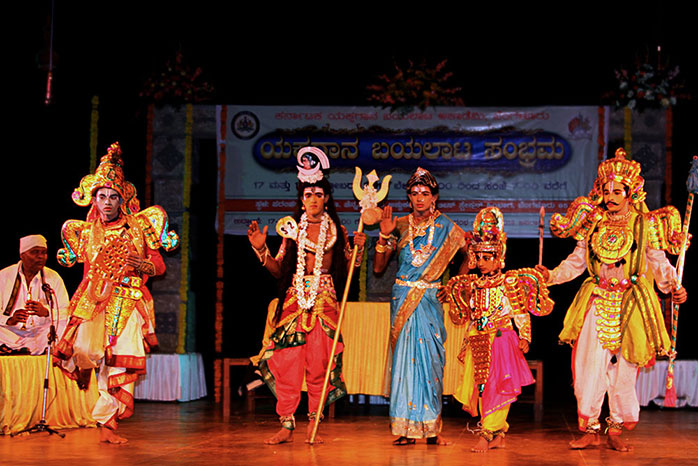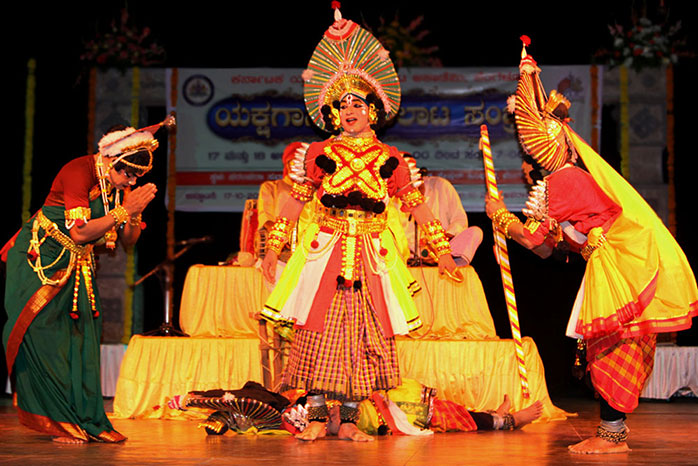Yakshagana performance generally begins in the twilight of the day with beating of the drum initially of many fixed compositions and last up to an hour before the actors arrive to the stage with resplendent costumes, head dresses and face paints. The dance is performed behind the curtain held by the Bhagavatha, after which the actors present different dances all to the same tune. Bhagavatha engages in conversation and introduces them with the songs of prasanga and interprets each character with a distinctive entrance. The songs are sung in the green room and moved to the stage by the Bhagavatha and Chorus. After all the characters are presented, the Bhagavatha appeals for a sympathetic response were the show begins.
Folk singers express every human feeling through the songs with simple words with a recurring beauty that strikes. Yakshagana composers generally takes up themes of varied human strife that succeed equally. Through the limited ragas they delineate emotions like love, anger, jealousy, fear, joy etc. Forms are usually created to express the content with the mythological themes. Bhagavatha sings to the accompaniment of sruti(drone) by playing a pair of small cymbals. The singer sticks to the high pitch with every song with spoken language accompanied by dance with narita aspects of footwork and rhythmical body movements.

Yakshagana performance presents the interaction of characters very much bigger than life, there is no realism in this presentation as it is usually mythological. This offers a colourful and overwhelming spectacle with the costumes and make up designed to this end. The colours chosen for make-up and the very lines and dots are selected to suit the presentation in the open air at night and in the artificial light to indicate the nature of each character. Pure white zinc, yellow, carmine pigments are generally used for valiant character that is generally surrounded by a red patch. The stage plays were also chosen Puranas, Ithihasas, Ramayana and Mahabharata with Hindustani/ Carnatic style of music. The actors generally wear magnificent costumes, head gears and face paints, with the ability of the actor’ scholarship there are variation in dances and dialog.
For a standard performance at least 8-9 people are required. Earlier the performance used to go on the whole night but now the maximum duration of the performance is two to two and a half hours where the language can be followed. Simpler concepts are popular among the villagers. Intellectuals are drawn the finer points like the intricacy of the dance steps, ragas in true yakshagana style and improvisations in dialogues. The performance may be enhanced by the costume, scenery, props, lighting, music and special effects. These help create the illusion of different characters, place and time or to enhance the quality of the performance.
On the stage the general practice is that the divine characters enter from the right wing and the others from the left wing. Sometimes the demons make their entry from the above. Some demons carry burning torches onto which inflammable powder ‘rala’ is sprinkled which would cause rising flames instilling a sense of fear among the spectators.
The singer has to sing the prasangas with adequate stress and elaboration in accordance with the scene and situation. This is especially noticeable when in a rendering of a poem or song the bhagwatha moves up to a high pitch and then abruptly ends the musical phrase. Another characteristic of Yakshagana music is the singing of one or two words and then stopping abruptly.


